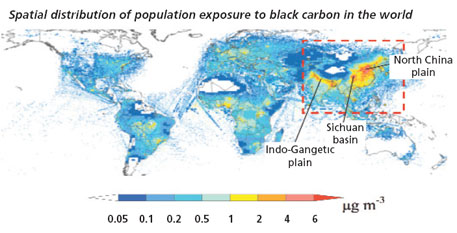



 ASTROPHYSICS
ASTROPHYSICS
Earth-like climate
The Milky Way has a lot of massive terrestrial planets, called Super Earths. It was believed that such planets do not have Earth-like atmosphere. ButÔÇêa recent study says that the chances of Super Earths having Earth-like atmosphere are quite high. The study says that such planets have oceans and visible continents, and store most of their water in the mantle. This set-up would allow the planets to have climate similar to that of the earth. The Astrophysical Journal, January 2
 TECHNOLOGY
TECHNOLOGY
Sensitive to GHG
An extremely sensitive and accurate device to measure greenhouse gases (GHG) has been developed. The portable device uses a thumbnail-sized quantum cascade laser to detect very small amounts of nitrous oxide (6 parts per billion by volume) and methane (13 ppbv). The laser is far more sensitive in measuring the gases than the commonly used lasers and opens the possibility of making the device as small as a mobile phone. Analyst, January 8 (online)
 HEALTH SCIENCE
HEALTH SCIENCE
Sleep disruption hits genes
Drastic change in sleep timing can disrupt gene expression cycle. A study on 22 people who were made to sleep during the day and stay awake at night, found that 1,356 (of the 1,396 genes tested) changed their activity time, impacting the release of chemicals essential for bodily functions. The study indicated that the impact on genes is not likely to be permanent. Also, it is still unclear if all genes return to normal when the routine is normalised.ÔÇêThe study could throw light on the disorders that people who work night shifts or suffer jet lags go through. PNAS, January 21
 ZOOLOGY
ZOOLOGY
Virus jumps from flowers to bees
Tobacco Ringspot Virus, a pathogen that infects plants, has also started infecting bees. The pathogen moves from infected pollens to the bee and impacts their entire body. The virus could have had a role in the mysterious disease that wiped out a large number of hives across the US in 2006. mBio, January 21
CHEMISTRY
Ink-free printing

Printers which use water are in the offing. These can be used to print on reusable and rewritable paper which has hydrochromic dyes. These dyes can be activated by water. The prints can be erased and rewritten dozens of times with no significant loss in colour quality. The paper is an eco-friendly option and can be used for printing documents needed for one-time read. Nature Communications, January 28
 BIOLOGY
BIOLOGY
Texting puts you off-balance
Texting while walking alters our posture and balance. A study on 26 healthy individuals has found that texting or reading makes people walk slowly and deviate from a straight line. The movement of the head while texting could be the reason for loss of balance. The study also found that the neck moves more when reading than when texting. PLoS ONE, January 22
 CHEMISTRY
CHEMISTRY
Atom-thick film works best
Molybdenum can be a cheap alternative to the more commonly used platinum for producing hydrogen from water. Hydrogen has great potential as an energy source but the platinum catalyst makes the process expensive. It has been found that the thinner the surface of molybdenum, the more efficient it is. One atom thick film of molybdenum was found to be most efficient, with the performance becoming five times worse by addition of another layer of atoms. Nano Letters, January 16
 ASTROPHYSICS
ASTROPHYSICS
Rare planets discovered
Three new planets in the star cluster Messier 67 have been discovered. Discovery of planets in star clusters is quite rare. The cluster is located in the constellation of Cancer, 2,500 light years from the earth. One of the planets discovered is orbiting a star identical to the sun. The discovery could help in finding the difference in mass and chemical composition of stars which have planets and those which do not. Astronomy and Astrophysics, January 15 (online)
 HEALTH SCIENCE
HEALTH SCIENCE
Sunbathing lowers BP
Sunlight lowers blood pressure and reduces the risk of heart attack. The skin has abundant quantity of nitric oxide which is involved in regulating the blood pressure. When exposed to the sun, the skin releases small quantities of nitric oxide into the circulatory system, lowering the blood pressure and improving cardiac health. Journal of Investigative Sciences, January 20
CLIMATE SCIENCE
Underestimated threat
Parts of India and China have much more black carbon soot in the air than earlier studies had shown. Black carbon is the charred remains of unburnt fossil fuels, biofuel, biomass and coal plants. The pollutant hangs in the air and is a health hazard. According to a new study, the presence of black carbon is twice or thrice more in parts of these countries than what previous studies had shown. The study uses new fuel consumption data from various sources to measure localised pollution levels, unlike previous studies which gave national figures and did not take regional differences into account. This methodology shows that the concentration of the pollutant worldwide is 130 per cent more than what was shown by earlier studies. Journal of Applied Ecology, January 19

We are a voice to you; you have been a support to us. Together we build journalism that is independent, credible and fearless. You can further help us by making a donation. This will mean a lot for our ability to bring you news, perspectives and analysis from the ground so that we can make change together.

Comments are moderated and will be published only after the site moderator’s approval. Please use a genuine email ID and provide your name. Selected comments may also be used in the ‘Letters’ section of the Down To Earth print edition.